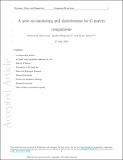Files in this item
A note on simulating null distributions for G matrix comparisons
Item metadata
| dc.contributor.author | Morrissey, Michael B. | |
| dc.contributor.author | Hangartner, Sandra | |
| dc.contributor.author | Monro, Keyne | |
| dc.date.accessioned | 2020-10-21T23:38:47Z | |
| dc.date.available | 2020-10-21T23:38:47Z | |
| dc.date.issued | 2019-10-22 | |
| dc.identifier | 261241882 | |
| dc.identifier | 14fc4781-eae6-453d-b20e-b8b42536eec7 | |
| dc.identifier | 85073968572 | |
| dc.identifier | 000494086700001 | |
| dc.identifier.citation | Morrissey , M B , Hangartner , S & Monro , K 2019 , ' A note on simulating null distributions for G matrix comparisons ' , Evolution , vol. Early View . https://doi.org/10.1111/evo.13842 | en |
| dc.identifier.issn | 0014-3820 | |
| dc.identifier.other | RIS: urn:E164E048ECCF45D273456418A4D4A9C6 | |
| dc.identifier.uri | https://hdl.handle.net/10023/20809 | |
| dc.description | MBM is supported by a University Research Fellowship from the Royal Society (London). KM is supported by a Future Fellowship from the Australian Research Council. | en |
| dc.description.abstract | Genetic variances and covariances, summarised in G matrices, are key determinants of the course of adaptive evolution. Consequently, understanding how G matrices vary among populations is critical to answering a variety of questions in evolutionary biology. A method has recently been proposed for generating null distributions of statistics pertaining to differences in G matrices among populations. The general approach facilitated by this method is likely to prove to be very important in studies of the evolution of G . We have identified an issue in the method that will cause it to create null distributions of differences in G matrices that are likely to be far too narrow. The issue arises from the fact that the method as currently used generates null distributions of statistics pertaining to differences in G matrices across populations by simulating breeding value vectors based on G matrices estimated from data, randomising these vectors across populations, and then calculating null values of statistics from G matrices that are calculated directly from the variances and covariances among randomised vectors. This calculation treats breeding values as quantities that are directly measurable, instead of predicted from G matrices that are themselves estimated from patterns of covariance among kin. The existing method thus neglects a major source of uncertainty in G matrices, which renders it anticonservative. We first suggest a correction to the method. We then apply the original and modified methods to a very simple instructive scenario. Finally, we demonstrate the use of both methods in the analysis of a real data set. | |
| dc.format.extent | 373866 | |
| dc.language.iso | eng | |
| dc.relation.ispartof | Evolution | en |
| dc.subject | Differentiation | en |
| dc.subject | G matrix | en |
| dc.subject | Null distribution | en |
| dc.subject | Quantitiatve genetics | en |
| dc.subject | Tensor analysis | en |
| dc.subject | QA Mathematics | en |
| dc.subject | QH301 Biology | en |
| dc.subject | 3rd-DAS | en |
| dc.subject.lcc | QA | en |
| dc.subject.lcc | QH301 | en |
| dc.title | A note on simulating null distributions for G matrix comparisons | en |
| dc.type | Journal article | en |
| dc.contributor.sponsor | The Royal Society | en |
| dc.contributor.institution | University of St Andrews. School of Biology | en |
| dc.contributor.institution | University of St Andrews. Centre for Biological Diversity | en |
| dc.identifier.doi | 10.1111/evo.13842 | |
| dc.description.status | Peer reviewed | en |
| dc.date.embargoedUntil | 2020-10-22 | |
| dc.identifier.grantnumber | UF130398 | en |
This item appears in the following Collection(s)
Items in the St Andrews Research Repository are protected by copyright, with all rights reserved, unless otherwise indicated.

